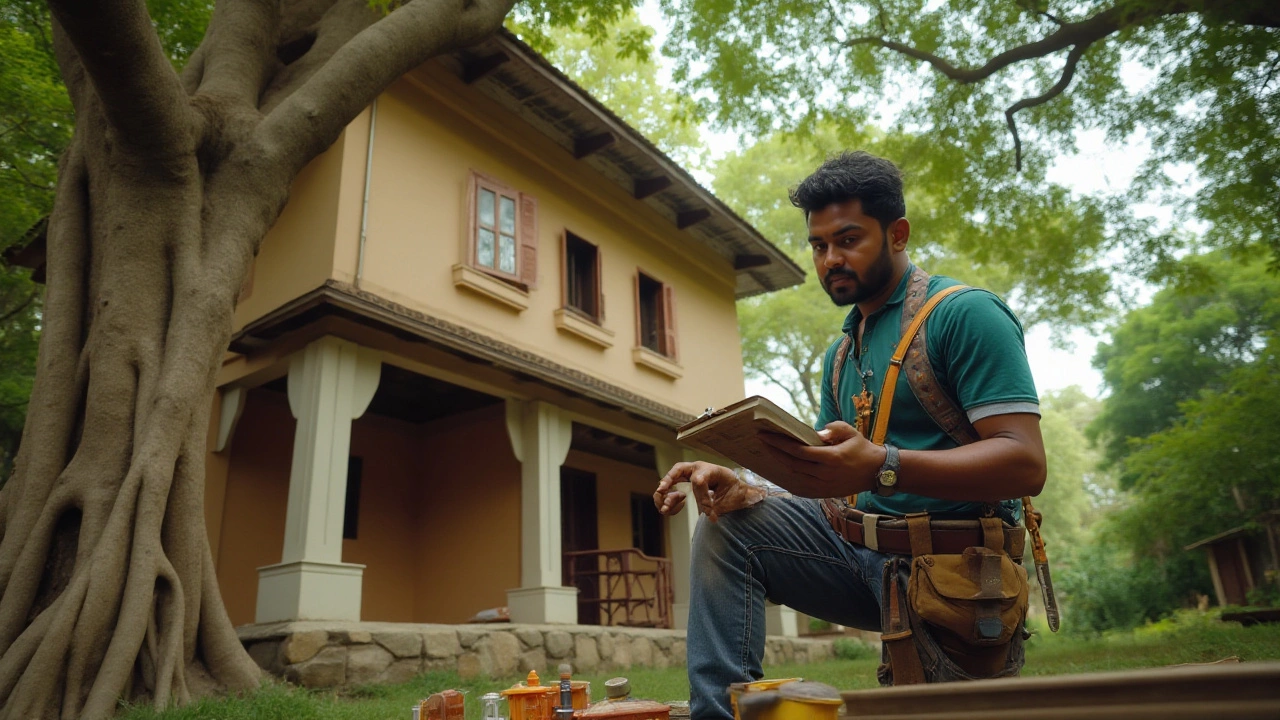Spotting that first crack in a new build is enough to make anyone’s stomach drop. But here’s the good news—most cracks aren’t disasters waiting to happen. They’re usually just the house settling in, sort of like when you break in a new pair of shoes. Still, if you want your walls to stay nice and smooth, it pays to know what causes these cracks and how to actually avoid them.
Don’t wait until you see that ugly line crawling up your wall. The key is to focus on the basics from day one. Keep an eye on how materials are handled, nail down timelines, and don’t try to rush the job—fast builds almost always end up with more cracks. Small changes in temperature or a sudden rainstorm during construction might not seem like a big deal, but they can mess with your walls and ceilings more than you think.
So if you’re about to build, buy, or move into a new place, it really helps to know what to watch for. Starting with a solid plan today can save you some major headaches tomorrow.
- Why New Builds Crack So Easily
- Getting the Foundation Right
- Choosing the Right Materials
- Managing Moisture and Weather
- Good Building Practices
- Aftercare and Monitoring
Why New Builds Crack So Easily
It’s kind of wild how common cracks are in brand new homes. It’s not usually about shoddy work—it’s just that new buildings act differently from old ones. When construction finishes, all the new materials start drying, shrinking, and shifting together for the first time. This early movement is called “settling,” and it’s one of the biggest reasons cracks pop up.
Let’s break down what really triggers cracks in new builds:
- Prevent cracks before they even start by understanding causes—like, how plaster dries way faster in a centrally heated home, making it pull away from the wall and form thin cracks.
- Most cracks show up in the first year. These are usually “hairline” and almost always harmless. But if you’re seeing cracks wider than 2mm, it’s worth double-checking with a pro.
- Modern homes often use lightweight blocks and faster-drying plasters to speed up the build. The faster stuff dries, the more stress it puts on joins, giving cracks a head start.
- Big swings in weather—like sudden rain or heat during construction—make building materials change size and even warp, which is a crack magnet.
Here’s a quick table showing when and where cracks show up most, based on a 2023 HomeOwners Alliance survey:
| Location | When They Appear | Common Width |
|---|---|---|
| Above Doors/Windows | 1-3 months | Under 1mm |
| Ceilings | 2-6 months | 1-2mm |
| Between Walls & Ceilings | First 6 months | Under 1mm |
| Brickwork (outside) | 6-12 months | 1-3mm |
The main thing to remember: every new home moves a bit at the start. It’s normal. The trick is learning what’s worth worrying about and how to stop minor cracks from turning major down the road.
Getting the Foundation Right
If there’s one thing that sets up a home for a long, crack-free life, it’s the foundation. Mess this up, and you’re pretty much guaranteed to see problems down the road. The soil you build on, how you prepare the site, and the way you pour your concrete all matter more than most people think.
Avoiding cracks actually starts way before the first brick goes down. The biggest trouble usually shows up when the ground under a house shifts or settles unevenly. It’s not rare—about 80% of domestic structural claims in the UK are linked to foundation movement. So why does this matter? Because when foundations move, the rest of the house gets pulled and pushed until something gives. That “give” is often a crack in the wall or ceiling.
Here’s what needs to be done:
- Check the soil. Clay soils shrink and swell the most, so if you’ve got that on your plot, you’ll need deeper or stronger foundations. Sandy soil drains better and is usually more stable, but don’t skip the checks.
- Prepare the ground. Removing tree roots and old debris isn’t just for show. Those things rot away or move, creating empty pockets under your foundation.
- Don’t pour concrete if it’s freezing cold or during a torrential downpour. Concrete hates extreme weather, and even one day of bad timing can weaken the whole thing.
- Use the right mix. Skimping on cement or rushing the mix means you’re more likely to get uneven curing and, you guessed it, cracks.
- Let it cure properly. Builders rush this way too often. Concrete needs at least 28 days to hit most of its strength, and drying it out too soon can spell disaster.
Want a sense of just how much foundation cracks can cost? Check out these average numbers:
| Cause | Average UK Repair Cost (2024) |
|---|---|
| Minor Foundation Repair | £1,000 - £2,500 |
| Major Underpinning | £6,000 - £15,000 |
| Full Foundation Replacement | £25,000+ |
When it comes to new builds, don’t just leave the foundation to chance. Getting this right is the single biggest step you can take to prevent cracks in your home.
Choosing the Right Materials
Your choice of materials can make or break your new build when it comes to stopping cracks. If you just pick whatever is cheapest or fastest to deliver, you’re setting yourself up for trouble. High-quality materials are less likely to shrink, warp, or flex as things settle, so spending a bit more upfront often saves a ton of hassle later.
Let’s break down what matters most. Bricks and blocks need to be properly dried before use—if they’re still holding moisture, they’ll shrink and pull apart from mortar as they dry out, causing hairline cracks. The same goes for timber. Using timber that's not properly seasoned is asking for broken joints and splits. If you’re going with plasterboard, check it’s suitable for your home’s specific humidity levels. Standard boards can’t handle a lot of damp. For flooring, use concrete mixes that don’t skimp on quality; cutting corners here leads to uneven surfaces and cracks in tiles or laminate later on.
- Prevent cracks by asking your builder about the specs for bricks, blocks, or timber before work starts.
- Insist on moisture-resistant plaster if your home is in a rainy area or prone to condensation.
- For areas that get a lot of movement, like hallways or around windows and doors, flexible fillers or jointing compounds really help.
- Reinforced concrete might cost a bit more, but it massively reduces the risk of slab cracks—especially on bigger projects.
Want hard facts? Check out this data from a 2023 UK construction study—projects using high-quality, pre-dried blocks and moisture-resistant plaster saw 45% fewer surface cracks within the first year.
| Material | Common Problem | Prevention Trick |
|---|---|---|
| Bricks/Blocks | Shrinking cracks | Use pre-dried, high-quality stock |
| Timber | Warping, splits | Only use seasoned wood |
| Plasterboard | Surface cracking from moisture | Pick moisture-resistant boards for wet rooms |
| Concrete | Slab/corner cracks | Choose reinforced and well-mixed concrete |
Bottom line: don’t cut corners on your materials. What goes in your walls, floors, and ceiling matters way more than any fancy paint or tiles you pick later. Good builders will always be upfront if you ask them these tough questions.

Managing Moisture and Weather
Water is sneaky. It can ruin even the toughest new build if it’s not handled right from the start. A lot of homeowners don’t realize how much prevent cracks relies on keeping moisture away during construction. Too much water in materials like concrete, brick, or plaster can leave them weak and ready to crack as soon as the building settles.
Building in the wrong weather makes things even worse. If it rains while concrete is setting, or if materials get soaked and don’t fully dry before use, you’re basically signing up for future cracks. Cold snaps and heatwaves are another problem—rapid changes make materials swell, shrink, and eventually split.
Experts agree timing is everything. According to the National House Building Council:
“Carrying out building work in poor weather or not allowing time for materials to dry hastens cracking and causes long-term problems.”
If you’re building or buying, here’s what you actually need to do:
- Protect construction sites with proper covers. Tarps and shelters aren’t just for show—they keep rain off fresh materials and unfinished areas.
- Schedule work for dry days whenever possible, especially when laying foundations or pouring concrete.
- Make sure wood, plaster, and other materials get enough drying time before sealing them up. Don’t let anyone rush this step.
- Check that builders use moisture meters to confirm things like concrete and timber are dry enough before moving on.
- Keep gutters, drains, and the area around the foundation clear during and after the build. Poor drainage is a crack’s best friend.
Paying attention to these basics really cuts down on hairline cracks—not just when you move in, but for years down the line.
Good Building Practices
If you want to prevent cracks in your new build, builders have to stick to some simple but important habits on the job. It starts with actually taking the time to do it right. Rushing through steps just to save a few days often leads to sloppy work, and those cracks can show up much sooner than you’d think.
Here’s what solid building looks like in the real world:
- Let materials dry out properly. That means concrete and plaster need their full drying time, which can be up to a month for concrete. Trying to speed this up with heaters or rushing to start painting is asking for trouble.
- Stick to recommended mix ratios. Skimping on cement or overdoing the water in your mix weakens the structure. Sticking to tried-and-tested recipes for concrete and mortar keeps everything more stable.
- Install movement joints where needed. Big stretches of wall or floor need somewhere to flex, especially in rooms with lots of sunlight or changing temperature. Builders should never skip these expansion joints in big spaces.
- Manage loads smartly. Heavy kitchen islands, bathtubs, or even upstairs gyms? It sounds obvious, but the structure has to support these without sagging—cracks often telegraph from beams or floors that aren’t properly braced.
- Get qualified people for each job. Every trade on site—framers, masons, drywallers—needs to know what they’re doing. One weak link, like an amateur drywall joint, can undo hours of careful work.
Don’t forget, a lot of these details are actually checked at inspection, but a quick look isn’t always enough. Ask your builder to walk you through what steps they’re following.
Here’s a snapshot of common building mess-ups that lead to cracks, along with how often they cause problems, based on a 2023 building survey:
| Issue | % of New Builds Affected |
|---|---|
| Skipped drying times | 22% |
| Poor concrete mix | 16% |
| No expansion joints | 13% |
| Improper load support | 10% |
As you can see, it’s usually the basics that get overlooked. Getting these right gives your new build the best shot at staying smooth, solid, and crack-free.
Aftercare and Monitoring
Just because construction is finished doesn’t mean you can stop paying attention. In fact, most cracks show up in the first two years, especially as the home adjusts to changing weather. Regular checks help you catch problems early, so you’re not surprised by a sudden split or gap months after moving in.
A smart move is to inspect your walls and ceilings once every season during the first year. Use a flashlight to spot even the tiniest hairline cracks in corners, above doors, and around windows. If you notice anything growing fast or wider than a coin, don’t ignore it. Here are some quick actions you can take if you spot a problem:
- Mark the crack with a pencil and write the date next to it—this helps you see if it's getting worse over time.
- If you spot doors or windows sticking, check if the frame's shifting or if there’s a crack in the wall nearby.
- For minor cracks under 2mm, flexible decorator’s caulk from a hardware store usually does the trick.
- If you see moisture around a crack, you might have a leak—call a professional.
- Keep an eye on any new cracks after big weather changes like a sudden cold snap or heat wave.
Bigger cracks or cracks that keep coming back should always be checked out by a builder or structural engineer. About 90% of cracks in new homes aren’t serious, but some can signal movement that needs fixing before it turns into a huge repair bill.
Humidity and temperature swings inside the house also play a huge role after you move in. Builders usually recommend keeping humidity around 50% to avoid both cracking and mold. Using a basic digital hygrometer makes this easy.
| Aftercare Task | How Often | What to Watch For |
|---|---|---|
| Visual crack inspection | Every 3 months | Hairline cracks, widening gaps |
| Check humidity | Weekly | Level around 50% |
| Test doors/windows | Monthly | Sticking, frame shifts |
| Look for moisture | After heavy rain | Damp patches near cracks |
Don’t forget—preventive care and regular home maintenance are your best bet for stopping small issues before they turn into big, expensive ones.



